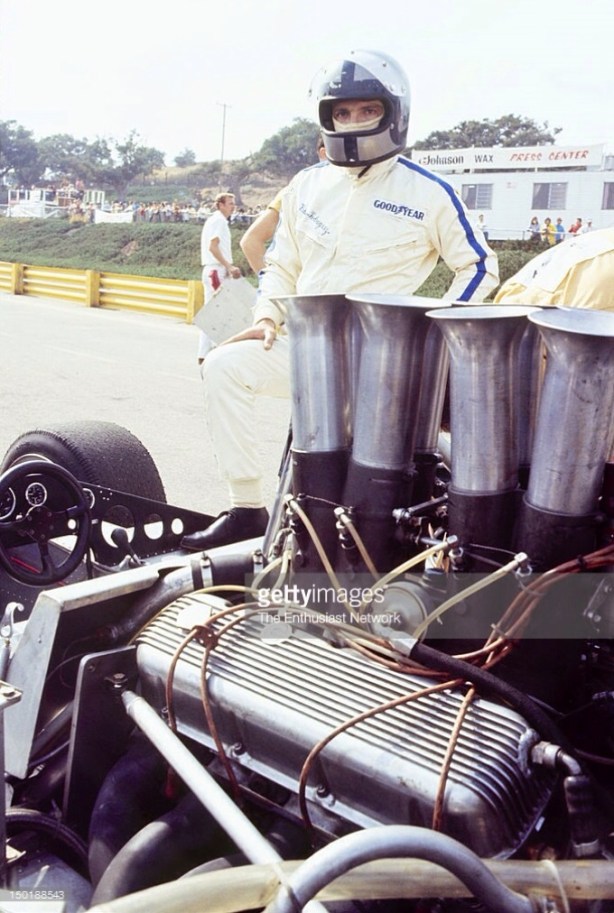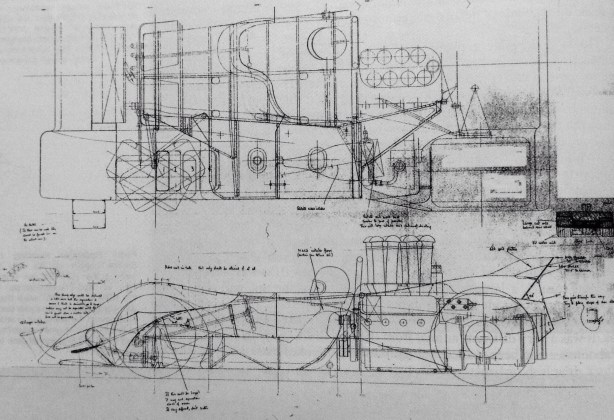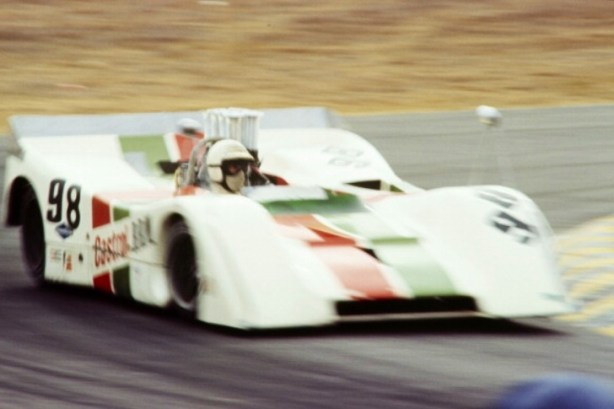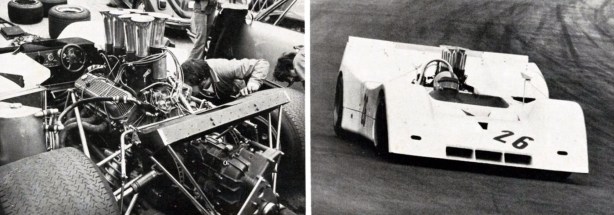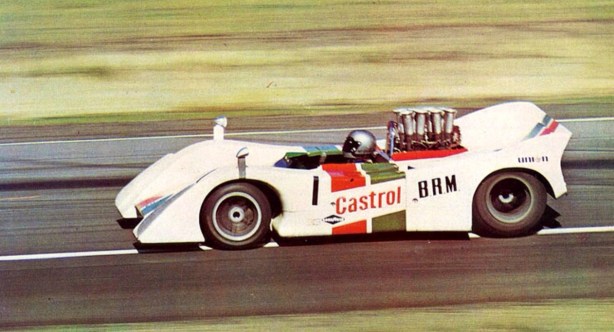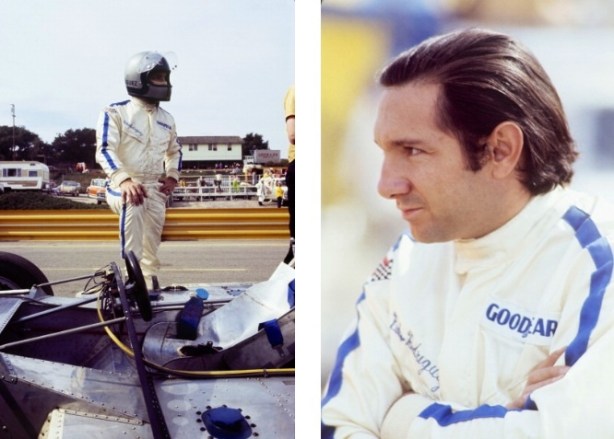‘yer don’t tend to think of Rodriguez as a Can-Am driver but he contested many races over the years without ever doing a full season’s program. A pity, as his fearless, blinding speed aboard big hairy V8’s would have been worth travelling a mile or three to see…
Here Pedro is with the 7.4 litre BRM P154 Chev during the Monterey Grand Prix weekend at Laguna Seca on 18 October 1970.
BRM built the P154 Chev to contest the 1970 Can-Am with George Eaton as its driver, the car was one of two brand new cars by Bourne’s just joined designer, Tony Southgate.

The immensely talented BRM Chief Engineer, team manager and designer Tony Rudd fettling his nemesis, the complicated, heavy and recalcitrant! BRM P83 ‘H16’, Monza, Italian GP practice in 1966 (GP Library)
BRM had two terrible years by their lofty standards in 1968 and into 1969. The BRM H16 engine was finally made reliable-ish in 1967 but it’s corpulence, it was well over 300 pounds in excess of it’s designed weight made the cars power to weight ratio poor whatever the chassis designers did to take weight out of the rest of the bolide.
The replacement P101 2 valve 3 litre V12, first raced by Bruce McLaren in his McLaren M5B at the Canadian GP in late 1967 was concepted as a sports car engine. Whilst light it wasn’t a match for the Ford Cosworth DFV’s power, torque, fuel efficiency or reliability, the same problems being confronted by Ferrari and Matra with their own V12’s. Into 1968 the DFV was being raced in numbers; by Lotus, McLaren, and Ken Tyrrell’s Matra International team.
As the Bourne engineers focussed on engines they lost their way with chassis direction, a strength prior to this. As a consequence Tony Rudd, who had masterminded BRM’s rise and consistency for over a decade left in mid-1969 to join Colin Chapman at Lotus.
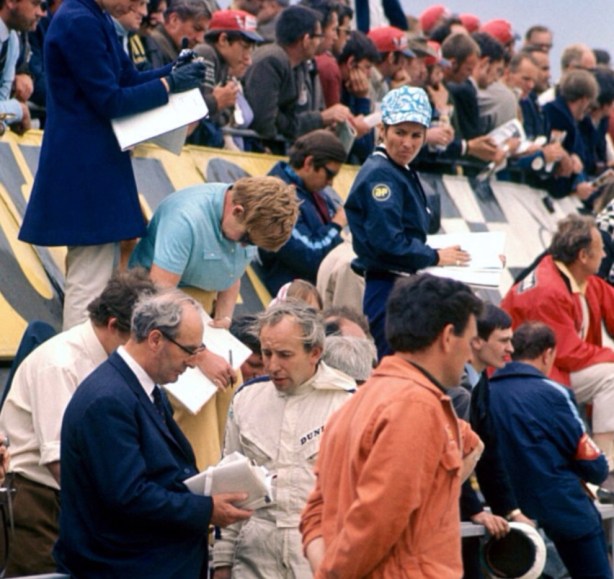
British GP practice, Silverstone 1969 with Surtees telling the boss just how shite things really are! Sir Alfred Owen, the immensely successful industrialist listens carefully and acts, with ‘generational change’ at Bourne. Allan Challis is the BRM mech in orange (Rainer Schlegelmilch)
’69 BRM driver, John Surtees was having a shocker of a season on both sides of the Atlantic, Jim Hall’s conceptually brilliant but flawed Chaparral 2H CanAm car was an even bigger ‘sheissen-box’ than his BRM F1 P139 BRM. Time was ticking in terms of his own driving career, he was 35 and had managed to land in the wrong team at the wrong time, twice in the same year when time was very much a precious commodity!

Surtees in the BRM P138 in Monaco 1969 practice. The cars all raced raced sans wings due to a CSI overnight safety decree severely limiting them. Surtees Q6 and DNF after Jack Brabham ran up his clacker when his gearbox failed, no injury to either driver (Rainer Schlegelmilch)
With BRM owner Sir Alfred Owen’s consent Surtees approached Tony Southgate, with whom he had worked at Lola on the T70 Can Am and T100 F2 cars and more recently designed competitive cars for Dan Gurneys ‘All American Racers’ in Santa Anna, California.
Southgate’s Eagle 210 Offy won the 500 in Bobby Unsers hands in 1968, he also designed a successful Formula A car and a stillborn ’68 F1 car design, elements of which were picked up in the Indy and ‘A Car’.
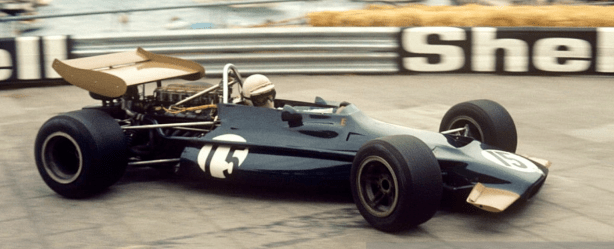
George Eaton at Monaco in 1970 in Tony Southgate’s brand new, BRG BRM P153 V12. Compare the ‘old and new’ P138 Monaco ’69 with P153 Monaco ’70 (The GP Library)
Southgate’s brief when he joined BRM was twofold; ‘do what you can now to get the P139 competitive and design a new car for 1970’…
The Brit quickly decided their was little he could do with the P139 so pressed on with the design of the P153, it and the evolved for ’71 P160 were front running, GP winning (4 wins) cars.
Whilst in the middle of the P153 design the chaotic BRM ‘decision making process’ determined that a Can Am challenger for 1970 was a good idea. It was a good earn after all. In a way it was a good decision as Southgate had Can Am experience at Lola and AAR but at the time focus on the ‘main F1 game’ would have been the more prudent course, but racers to the core the BRM outfit were!
Given the designation P154, the car was very much a wedge-shaped device, developed at quarter scale in the Imperial College wind tunnel, then in MIRA’s full-size tunnel when it was completed.
Southgate recalled testing the car at MIRA (Motor Industry Research Association test facility); ‘MIRA has a large test track, with high banked corners to enable high average speeds to be maintained…the one and only Jaguar XJ13 was there for a filming run…an hour or two later whilst in the wind tunnel we heard a load bang. The XJ13 crashed violently at 125mph when a rear wheel collapsed, it rolled four times, I’m glad to say Norman Dewis, Jag’s legendary test driver was only bruised’.
‘By comparison with the 1965 prototype Le Mans car, certainly pretty but what then seemed like old technology, basically it looked like an E Type with an engine in the middle, very round in section with low drag the clear priority. By comparison the P154 was very aggressive looking, wedge-shaped with square sections and downforce was written all over it.’

‘The P154 model in the Imperial College wind tunnel. There was no moving floor in those days so the wheels were fixed with a small 1mm gap between them and the floor. The model was covered in chalk and paraffin so that when it dried the chalk left a surface air flow pattern for studying.’ (Tony Southgate)
The P154 had a neat lightweight monocoque chassis, the front suspension was similar to the P153 with a single upper link, lower wishbones, coil spring/Koni shocks and an adjustable roll bar. But the rear suspension was quite different as Southgate sought to run the exhaust low down, locating the exhaust primaries below the rear suspension lower wishbones, the aim was to lower the CG. ‘The end result looked good’. The suspension itself was conventional, single upper link, lower wishbones, twin radius rods for forward and lateral location and coil spring/Koni shocks and adjustable roll bar.
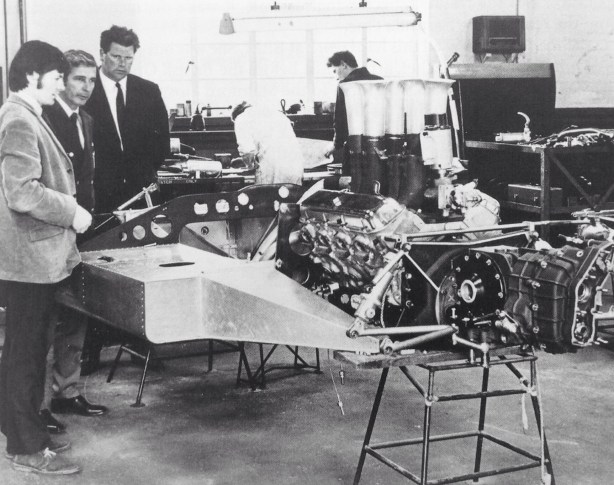
‘The prototype BRM P154/01 being assembled at Bourne. I am showing (TS left) the Castrol USA representative (sponsor) around whilst Tim Parnell (team manager at right) looks on. The monocoque was quite neat and full-length, finishing at the gearbox. The engine is a Chevy developed by BRM, the gearbox a Hewland LG500.’ (Tony Southgate)
Designed for super wide 19inch wide Firestones which never appeared, the car always looked ‘over bodied’ with the 17’s the car raced with. This contributed to the handling dramas attributed to the beast.
The engine was built in-house at BRM and seemed competitive; Chev ZL1 aluminium blocked 7.4 litre, Lucas injected, magneto ignited, dry sump V8 developing circa 650 BHP. The gearbox was one of Mike Hewland’s LG500’s.
The car had little testing, ‘it was thrown together and sent to America for the mechanics to sort out on the hoof” Southgate quipped in a MotorSport interview. The poor unfortunates sent to the US with the car were Roger Bailey and Mike Underwood!
The car sorely needed testing as BRM’s first Can Am machine and the cars driver, Canadian George Eaton didn’t have the experience of big sports cars of both other 1970 BRM F1 drivers, Pedro Rodriguez and Jackie Oliver. ‘It was a low budget operation and the results reflected that. For me, it was a distraction at the time from the real thing-Formula One’ said Southgate.
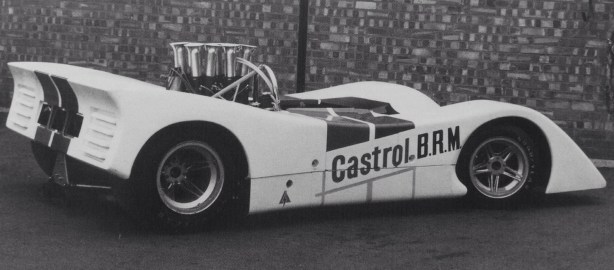
‘The completed P154 outside the Bourne workshop in 1970. Note the paintwork was not complete when this photo was taken. In this shot you can see the undersized tyres front and rear, which proved a problem on the circuit (Tony Southgate)
Racing the P154: George Eaton 1970…
Eaton was far from devoid of ‘Big Car’ experience, however.
He raced a McLaren M10A Chev Formula A, 5 litre chassis successfully in North America in 1969 and had raced customer McLarens in the Can Am since 1967.
He was a very strong performer in his beautifully prepared McLaren M12 Chev in the 1969 Can Am consistently qualifying in the top 6 in a field with great depth of talent. His best results were in Texas 2nd, Edmonton 3rd, Watkins Glen 4th and Mid Ohio 6th. He was a bright young spark in these, big, demanding cars.
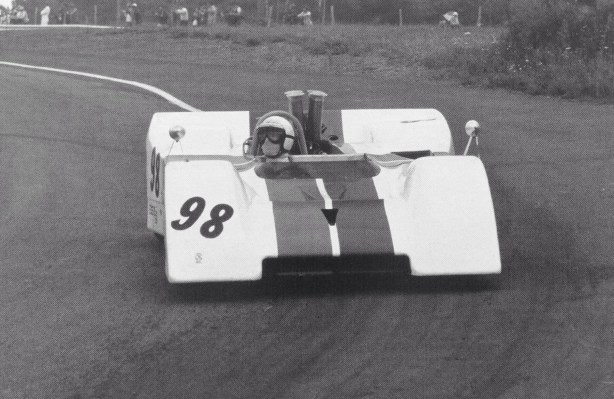
‘An early race for the P154, George Eaton, Eatons distant 3rd at St Jovite Canada being a rare highlight’ (Tony Southgate)
So George knew what a good, sorted McLaren was all about and how to drive it figuring a bespoke BRM works car would be a very good thing. Which it was not! The lack of development miles told in the early part of the season.
He qualified 7th at Mosport and 3rd at St Jovite for a DNF with oil and transmission problems and a strong 3rd place. At Watkins Glen he had brake failure, Edmonton a wheel bearing failure and at Mid Ohio fuel pressure problems having qualified 13th, 6th and 25th. At Road Atlanta an engine blew having qualified 5th.
Pedro Rodriguez joined the series from Donnybrooke in September where he was 9th, ‘it didn’t go well in Eaton’s hands so we put Pedro in a car’ was Southgate’s quip, it rather implied the problem was George, which it was not. The Mexican finished 5th at Laguna and 3rd at Riverside but was out qualified at each round by George. Frustrating for Eaton was Pedro’s results given the hard yards he had put in. He had rocker failure at Donnybrooke and crashes at both Laguna and Riverside, in the latter event a practice shunt which prevented him taking the start.
No way did Eaton have Pedro’s speed in a GP BRM but he was certainly mighty quick in a Can Am car. Southgate ‘Pedro wasn’t a technical driver , he’d just get in and drive his heart out’, clearly Eaton was quick, Pedro was Top 5 in the world at the time, Top 7 anyway! One rather suspects the P154 needed testing miles with a development driver to both stress componentry, the role Eaton played in races early in the season and to re-engineer or tweak the package to make it behave. Southgate says the suspension geometry, designed for 19inch wide tyres didn’t work well with 17’s.
Best results for the P154 in a season dominated again by the papaya McLarens, the M8D in 1970, were George’s qualifying performances at Road Atlanta and Donnybrooke, his 3rd place at St Jovite, Pedro’s 3rd at Riverside and 5th at Laguna.
In essence Eaton did a very good job with an under-developed, evil handling car, one of the best in the world also struggled with it…
Development of the P154: Pedro raced the car later in the season and afterwards ‘came to see me in my office in Bourne to talk about the experience and told me in its present form the car was horrible to drive’ said Southgate.
‘I had great admiration for Pedro, so I knew it must be really bad. I was very embarrassed and immediately set about re-engineering it and fixing all the problems. The revised car, the P167 went on to be very good in 1971 but it was still a low budget operation’.

This is an interesting drawing of mine because it shows the wind tunnel development shapes that were produced to arrive at the distinctive ‘shovel’ nose on both the P154 and P167. The heavy line indicates the final shape.’ (Tony Southgate)
Modifications to make the car competitive comprised a large rear wing, widening the front and rear tracks to get the outsides of the wheels out to the most extreme width which the proposed for 1970 19 inch wheels were supposed to achieve. The front to rear balance was achieved with a shovel-type concave nose section. ‘It was the same design theory I arrived at in the wind-tunnel for the nose of the P160 ’71 F1 car.’

The 1971 BRM P167 was a P154 extensively modified.’…A new shovel nose section was added, new rear bodywork created and a rear wing fitted. The tracks, front and rear were widened.’ (Tony Southgate)
In fact when Howden Ganley, the talented Kiwi mechanic, engineer, racer and test driver drove the 1971 evolved car, the ‘P167’ at Goodwood the nose ‘grounded’ under brakes as so much downforce was being created. The fix was making the nose mounts more rigid.
Said Tony, ‘This was my first experience of very large aerodynamic loads deflecting the structure. The phenomenon was the visual interpretation to my understanding the sheer power of aerodynamics which could be produced on a modern car’.

‘The BRM developed Chevy V8 performed well and was quite reliable, the trouble was we had no spare available. The car ran without bodywork between the wheels as shown here.’ 1971 P167 (Tony Southgate)

‘The rear view of the P167 shows the exhaust system, which was unusual for a US V8 engined car. I liked it because of the lower CofG’ Note the rear suspension; single upper links, lower wishbones, coil spring/Koni alloy body dampers and roll bar. Inboard discs, LG500 Hewland ‘box with oil cooler above and magneto above it again. Note ‘stays’ to locate ‘mudguards’ above lower wishbones and monster wing compared with wingless P154 (Tony Southgate)
In a very limited Group 7 program by BRM in 1971 Pedro first raced the P167 in the European Interserie at Zolder in June, for Q7 and a DNF with a cylinder liner problem. He missed the next couple of rounds and then came the fateful Norisring round at which he lost his life, more of that below.
In September Brian Redman drove the P167 to a win at Imola and then in early October at Hockenheim against good fields, not Can Am quality mind you. The car was entered by Sid Taylor Racing, that year also running Brian in European F5000 events in a McLaren M18 Chev.
Buoyed by those results the Bourne hierarchy shipped the car to North America to contest the last two Can Am rounds in California. The car was raced again by Sid Taylor with his team providing the support. Jerry Entin and engine man George Bolthoff were with the team at both US races.
At Laguna Seca, Brian was Q6 and a strong 4th, and Howden Ganley raced the car at Riverside, Redman stayed in Europe to attend Jo Siffert’s funeral. The poor Swiss perished at the wheel of a BRM P160 at the end of season, 24 October, Brands Hatch ‘Victory Race’ after a tyre failure, the tyre moved on the rim and suddenly deflated, causing him to veer off the track and roll in the dip before Hawthorn Bend. He was almost uninjured but perished in a horrible fire. The plucky Swiss started the race from ‘equal pole’ with Peter Gethin, it demonstrated his competitiveness right to the very end of his career.
The talented Kiwi, Ganley a BRM F1 driver that season qualified 9th and finished 3rd behind the dominant McLaren M8F’s in the P167.

Howden Ganley at The Times Grand Prix, Riverside, P167/01 in 1971 definitive form, 4th (The Enthusiast Network)
‘Alcan Team BRM’ ran the car as a works entry in the 1972 Interserie with Ganley scoring wins at the Nurburgring and Zeltweg amongst a swag of DNF’s for the P167. Mike Pilbeam engineered the car with Reg Richardson, principally an engine man, the cars mechanic. Once the Porsche 917/10 appeared in Europe the going got much tougher for the V8 brigade, Leo Kinnunen took the title, Porsche mounted in ’72.
In an unfortunate and bizarre sequence of events the P167 led to Pedro’s death, Southgate again; ‘During 1971 when the P167 was showing promise, Pedro decided he wanted to race it in Europe. So the car was entered for the big Interserie race on the Norisring street circuit in Nuremberg’
‘Part of the preparation was to re-run the engine on the Bourne dyno, hoping to find a few more horsepower. Tragically, as it transpired, the engine was damaged and we had no spare so we cancelled our entry’.
Pedro ‘phoned me that evening to see how the cars preparation was going, only to be told as far as we were concerned the race was off. I told him I was sorry for letting him down. ‘Never mind he said, I have been offered a drive in a Ferrari (512M) for good money-£1500′. I wished him luck in the race. Little did I know this would be the last time that I ever spoke to Pedro. He was killed driving that Ferrari’.
Tony Southgate has very fond memories of the great Mexican; ‘Pedro was extremely popular with everyone and I admired him both as a person and driver. He was a charismatic character with a particular aura about him, always appearing immaculate to the outside world, sleeking back his hair and wiping his brow after driving before he would talk to anyone. Actually he was a very private and quiet man…He never was a balls out qualifier; he preferred to save his efforts for the race. When his grid position was not as near the front as we would have liked, he would tell us that he would simply overtake a few cars on the first lap, which he often did. He was easy to work with, not a technical driver, but naturally talented and brave. Very brave…’
Bibliography…
‘Tony Southgate: From Drawing Board to Chequered Flag’ Tony Southgate, MotorSport interview by Simon Taylor, Jerry Entin on ‘The Nostalgia Forum’, classiccars.com
Credits…
The Enthusiast Network, Southgate biography as above, Getty Images
Build Numbers…
British racer and former twice national hillclimb champion David Hepworth bought all of the chassis’, patterns, drawings and moulds when BRM dropped the Can Am program, his best Interserie result was 5th at Silverstone in 1972.
It appears there were 5 chassis built: the two P154’s raced by Eaton and Rodriguez in 1970- P154/01 and P154/02. P154/02 was reduced, it’s parts donated to the P167 program, in recent years the car has been rebuilt/reassembled.
There was one P154/167 and two P167’s. The P154/167 ‘bastard car’ combined the P154 short wheelbase with P167 suspension geometry- this car does not appear to have been raced upon perusal of published records.
Rodriguez, Redman and Ganley raced the definitive P167/01 in 1971 in both the Interserie and Can Am.
Ganley raced P167/01 in the 1972 Interserie, Vern Schuppan practiced the same chassis but did not race it at the Nurburgring after engine failure in practice. Hepworth raced P154/01 in 1972 and in the 1973 Interserie, P167/01.
P167/02 was assembled later from spares acquired in the ‘job lot’ acquisition of cars and parts from BRM in 1972- it appears, entered for Hepworth, at the Nurburgring Interserie in 1974.
For many years the Hepworth family owned four of the five cars. I’m not sure of the present status of said racers but wouldn’t P167/01 be a nice thing to have?- ex-Rodriguez, Redman, Ganley, Schuppan and Hepworth…
Tailpiece: Racers Racer…
